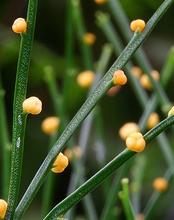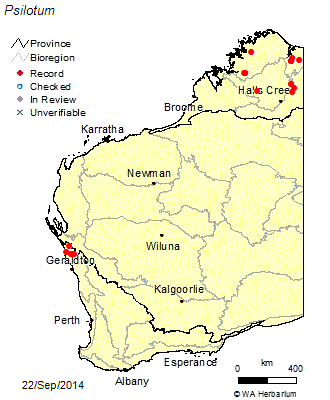The genus Psilotum comes from the family Psilotaceae and has only two species, Psilotum nudum (image 1) and Psilotum complanatum (image 2). The common name for Psilotum is 'whisk fern' (Atlas, n.d.).

Image 1. Psilotum nudum (image retrieved from http://www.adonline.id.au/plantevol/psilotum-nudum/).

Image 2. Psilotum complanatum (image retrieved from http://www.botany.hawaii.edu/basch/uhnpscesu/htms/npsapln2/fish_pops/psi...).
Not threatened and current (Department of Parks and Wildlife, n.d.).
Nil
This genus can grow either on the ground or on another plant. They produce only one type of spore and their underground stem system, which is divided into two parts, lacks roots and does not contain the pigments necessary to convert light into energy. They have an aerial shoot system that can be erect or overhanging and can also be divided multiple times. It has small leaves which do not produce spores. The leaves are scale-like and lack a vascular nerve, they split into two and are spore producing. There are many large spores that are yellow in colour and double sided (image 3). The gametophytes are found underground with fleshy roots that are similar to rhizomes. The plant’s eggs and sperm can be in zones or consistently spread out.

Image 3. Close up of Psilotum nudum large yellow spores (image retrieved from http://www.adonline.id.au/plantevol/psilotum-nudum/).
-Lack of true leaves, seeds and flowers (Dimech, 2011).
-Vascular system is only half of normal plants (Dimech, 2011).
-Nutrient uptake by forming bonds with mychorrhiza (fungi) (Dimech, 2011).
Psilotum hold onto some primitive features of the first ever land plants (Kumar et al, 2006). Psilotum is said to be a close resemblance to plants that existing millions of years ago in the Silurian era (Dimech, 2011). The features of the plant today are similar to distant ancestors in the way that they do not have true leaves, seeds or flowers (Dimech, 2011). It is the distinctive features that make the history of the plant so important (Dimech, 2011)
Kingdom: Plantae
Phylum: Charophyta
Class: Equisetopsida
Subclass: Ophioglossidae
Order: Psilotales
Family: Psilotaceae
Genus: Psilotum
(Atlas, n.d.).
Thrives in tropical and subtropical environments and therefore can be found in Florida, Mexico, several Pacific Islands, Hawaii islands, India and more (EOL, n.d.). Psilotum is also found in several places within Australia (image 4), most abundant on the east coast of Australia. There are also several areas in Western Australia that Psilotum is present in (image 4). Psilotum nudum is native to Western Australia (Department of Parks and Wildlife, n.d.). It is also found in New South Wales, Queensland and Victoria (Dimech, 2011). Psilotum complanatum is not found in Western Australia but is in South Australia (EOL, n.d.).

Image 4. Map of Psilotum distribution across Australia (image retrieved from http://bie.ala.org.au/species/urn:lsid:biodiversity.org.au:apni.taxon:30...)

Image 5. Map of Psilotum distribution across Western Australia (Image retrieved from https://florabase.dpaw.wa.gov.au/browse/profile/20872).
Shrub land, aerial habitat and subterrestrial habitat (EOL, n.d.).
Used as a similar product to talcum powder for chafing; used medically; used as a broom to sweep; and can sometimes grow as a weed in a greenhouse (Carr, 2010).

Recent comments